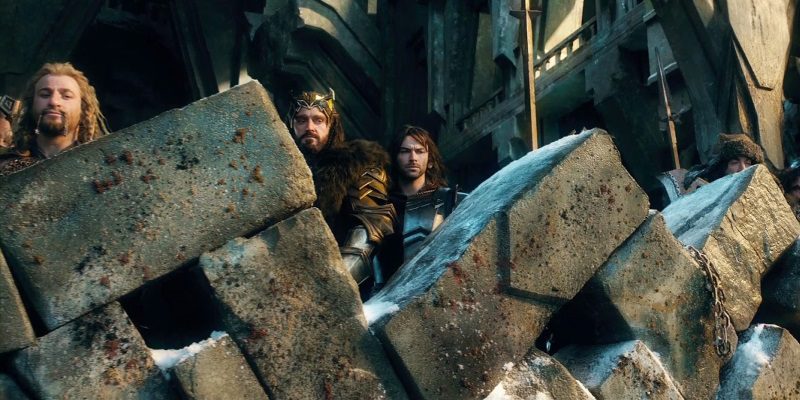Tribal Knowledge: Dungeon Remodeling Projects

I am a huge fan of the StoryNexus game Below. When I reviewed it in Harbinger of Doom, I talked about how much I liked the way it lets adventurers alter parts of the dungeon to their own convenience. I may have even waxed a touch loquacious about it. I can’t remember the last time I was accused of being concise, though. Anyway, I like the idea enough that I want to suggest more things in this vein that one might use in other dungeon crawls. (These aren’t specifically for Below, just dungeon-crawling games in general.)
First, Some Theory
Making a lasting change in the world emphasizes agency and ownership. The second encounter that takes place in a location takes place in the context of the first, resulting in a richer experience of expectation and informed decision. Film criticism often talks about the setting as a character unto itself; in games this takes on a functional truth, if the players can observe its development over time. (And then there’s 13th Age dungeons.)
Changing the environment can be the main reason for exploring of the dungeon, instead of murdering the inhabitants or gathering up copious lucre. I bet your players have done every possible variety of Just Murder Everything That Moves – wouldn’t some variety be nice? This could be a strong move toward greater campaign themes of repair and renewal. Surprisingly, these are lessons that video game level designers (the Overlord franchise and the Legend of Zelda franchise come to mind; The Sword of the Stars: The Pit touches on these ideas without a full exploration) and Hollywood action flicks (the climax of The Hobbit: Desolation of Smaug) have implemented most impressively, and now it’s time for tabletop games to explore this space.
Some of you are saying to yourselves, “I go into dungeons to explore – to see new things. Going back to a location and having more encounters there is exactly counter to my goals as a player. Once a room is cleared, why should I have to clear it again?” To this I say a couple of things.
- Why are you even mapping this joint if you don’t care about where you’ve already been?
- I bet you also want the GM to make the dungeon feel “alive.” Discovering that monsters can move from one room to another, even rooms you’ve already seen, is the minimum expression of that point. A dungeon that the players can actively modify is another step on that path.
I really miss 4e’s terrain powers, too. They’re a great way to get PCs to engage with the physical space of a fight, though they have to be pretty strong to compete with a 4e character’s other options. I haven’t yet seen a particularly convincing 5e implementation, in part because of questions around damage scaling, I suspect. Now, the DMG has a chart for trap damage scaling, but I think that imposing conditions is the Big Answer for terrain use here. But I digress.
The High Labyrinth of Argent
Within the dungeon, there is a room where the marble floor mosaic has been broken up by the passage of great beasts and many battles. If it were repaired with a great effort, it would be the mosaic of a massive, complex labyrinth. According to ancient lore, the High Labyrinth of Argent once offered power and insight to those who walked its pattern. (Ahem, if this sounds like I’m ripping off Zelazny… I’m willing to own that. Also, Zelazny was just a master of adapting mythology in the first place.)
Repairing the High Labyrinth of Argent requires several hours of work. The chamber is an ideal place to bar the doors, rest, and recover spells, though. It’s located on one of the higher (that is, nearer to the surface) levels of the dungeon, so that the players can and probably will come back to the chamber, but it represents some sacrifice of progress. This should be tuned to feel like a tradeoff, but a valid one.
Any number of different skills might work for the repair; for 5e’s skill list, I might suggest Athletics (handling the weight of the tiles without causing further damage), History and Religion (recalling the lore of how the High Labyrinth was structured), and proficiency with Mason’s Tools. If no one in the party has proficiency with Mason’s Tools, maybe they can find broken pieces of tile taken from the labyrinth as loot, fix them up with mending, and set them back into place.
When reconstructed, a character can walk the labyrinth (ahem, labyrinths are not puzzles). The character makes a difficult Wisdom (Insight) check and spends an hour. On failure, the character gains advantage on her next Insight check (that cannot be applied to further labyrinth checks). On a success, the character gains advantage on her next Wisdom check or saving throw of any kind. These two outcomes do not stack; the success result overwrites the failure result.
It’s probably also a good idea to give the High Labyrinth of Argent additional exit paths, either to dungeon levels above and below, or directly to the surface. What with being a labyrinth, I’d suggest that characters could make an alternate skill check in walking the labyrinth that teleports them to a surface location. That surface location might have a parallel teleportation into the dungeon – one particularly interesting version is a location that teleports characters into the High Labyrinth of Argent as their initial entry into the dungeon, only to reveal that there is no exit until they repair the mosaic or find a new way out. (Maybe they even have to track down unbroken tiles from other half-ruined mosaics in the dungeon.)
The Forge of Tsaritsa Aveline
Some years ago, the Empire of Koskjova suffered grave losses in war as a result of internal division and enemies on every front. As a result, it was necessary to rebuild the army as quickly as possible; thanks to a limited number of available soldiers, the defenders of the empire needed to account for thrice their number in battle, time and again. To achieve this, the Tsaritsa Aveline ordered the construction of an innovative new design of blast furnace that made not steel but the true adamant, in the city of Oplot (that is, fortress) Drezna. It was a mighty citadel, responsible for defending the Empire from many of the dread foes that threatened it. Though they endured for many years and broke the great siege, the Empire’s doom could not be stopped by any mortal craft.
With the fall of the city of Oplot Drezna, the Forge was ruined, but it could be restored by one with sufficient skill and dedication. The forge itself is in a massive chamber deep below the surface. Restoring the forge requires skill checks in the general theme of Smith’s Tools, Thieves’ Tools (to clear away delicate machinery without doing further damage), and Perception. This involves accessing several different areas – the air intake and vent are blocked near the surface, the chain of the trip hammer needs to be reattached in the mid-depths, and so on.
Once repaired, the forge can smelt adamant, repair damaged gear (if that’s a thing in your system of choice, or if the party discovers damaged gear), turn relatively worthless raw materials found elsewhere in the dungeon into ingots of refined metals, and allow rapid ascent or descent between dungeon levels (by attaching oneself to the trip hammer chains). Finally, some part of the forge – the fire, the trip hammer, I dunno – is necessary to pierce a boss monster’s nigh-invulnerability, so the PCs have to lure that opponent into the main chamber of the Forge and seal the doors against escape. (The point of this aspect is to ensure that there are at least two encounters here – one using the terrain powers of the forge in ruin, and one after its repair.)
The Statue of Opal Eyes
In my campaign, a group of low-level characters got sucked through a portal into some kind of pocket plane that, fortunately for them, isn’t the Domain of Dread. In exploring it, they found an altar with a ten-foot-tall statue. The statue depicted a four-armed humanoid figure, with each hand positioned in a different somatic component. The statue’s eyes were inset opals. When they searched the base of the statue, they found a secret compartment with five more semi-precious stones, sized to fit into the hands. When they placed a gemstone into a hand, they could activate a potent magical effect out of it.
Now, when I ran this, I wasn’t thinking in terms of having them repair the scenery. If I had, I totally could have made them go get the arms from other parts of this pocket plane. A missed opportunity, but to be fair I have raked them over the coals with this adventure so far, so letting them find one thing that worked right without major effort is probably fine. Anyway, this is a relevant example because they’ve returned to the statue several times to try new things, use up more of the gemstones, and rest – they can’t take a long rest anywhere else, but when they activate a gem in an Abjuration-gesture hand, they can slumber safely in area around the statue, and even received the effects of a Recuperate action.
It would also be cool if they had started with one gemstone (which of course they need immediately), and intermittently find more gemstones to feed to the statue as they explore. Creatures or locations that require an unusual currency that is specific to that adventure or dungeon complex can be fun and interesting – it helps that the PCs can confidently spend down to zero when they leave the dungeon, not worrying about saving for a future need.
Other Ideas That I’m Not Developing Right Now
I’m not writing up adaptations of the Waypoints that Below uses, because I don’t want to just lift Chris Gardiner’s ideas. Go play his game, because it is wonderful. The general theme, though, is that when fully improved, each Waypoint purges two of the game’s negative conditions, grants a small-but-useful amount of Gear, Secrets, or Treasure (the game’s three primary currencies), and allows you to change your Depth. D&D doesn’t do long-lasting negative conditions the quite the same way that Below and Torchbearer do, but 3.x D&D has reasonably good parallels (especially in ability damage/drain), 4e has its disease track, and 5e could probably stand to add a few curses or other conditions that function about like a disease on a rules level.
For more variety, I might add longer-term buffs of some kind – the Concentration rules of 5e would make this especially potent, if the location “carried” the Concentration requirement of the spell for a span of time. The problem then becomes setting things up so that players don’t return to the location and renew buffs every single time the buffs expire. I imagine some kind of doom track timer in the dungeon, a scaling cost associated with the buff, or relatively heavy use of wandering monsters as all being workable.
The real goal is to make this dungeon stand out from all of the other dungeons your players have seen for years. (I am personally not a huge user of mega-dungeons, but it’s clear from reading a lot of gaming blogs that most mega-dungeons are both playing to a narrow range of experiences and struggling to break out of that mold.) Don’t be afraid to let the upgraded location radically change one of the core assumptions – just like the portal gun makes Portal unlike any other shooter you’ve ever played, let the players get deeply attached to one or more locations, and let its rules make this campaign unlike any (system of choice) they’ve played before.
You might do that by changing up how spells refresh within this dungeon or how PCs regain hit points. Maybe players can drink from a blessed well all they want and always return to full health, but doing so builds up some other negative quality? Radically changing the playstyle of the cleric class could be neat. I’d generally say to avoid having the centerpiece location make things worse for the players on the whole – that nudges them toward avoidance, even if that isn’t the solution. On the other hand, if the dungeon as a whole carries the Curse of the Mummy’s Tomb (dun dun DUNNN!), then that’s fine and good.
The comments field is, of course, open to more ideas!



